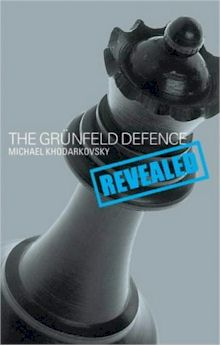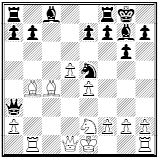Back to: Chess Main Index
 The Grünfeld Defence Revealed, by Michael Khodarkovsky (2003 Batsford) £14.99.
The Grünfeld Defence Revealed, by Michael Khodarkovsky (2003 Batsford) £14.99.
Book Review
by Graham Brown
THE Grünfeld Defence Revealed is a brand new first edition book, which is the start of yet another series of books about ... the openings! The sequence will, it is claimed, present the "key aspects of each chess opening in a fresh, entertaining and accessible way". TGDR is a great start I think.
IM Khodarkovsky begins with a look at the basic ideas and spirit of the opening and how these related to the political and historical backdrop of the times ...
It is 1921 and a young Austrian, Ernst Grünfeld, is developing a new opening strategy, "as radical as the emerging Modernist movement in wider society". One of the principal ideas behind this exciting, asymmetric strategy, was that White was allowed to occupy the centre with his pawns. "But White is simply better!" ... the Tarrasch old school would cry. But Black disagrees; he is engaging in classic guerrilla warfare. White is in the centre of the Black city, but instead of trying to repel the invader with hand to hand combat, the army hides out in the foothills and snipes at the sitting target below.
The author explains that "This must have seemed a radical approach in the early 1920s when the trench warfare of openings such as the Queen’s Gambit Declined and the Ruy Lopez was de rigeur." Complex war-strategy analysis aside, the opening actually worked in practice, and in 1922 Grünfeld used it to beat Alexander Alekhine among many others. With the breezy and authoritative way the basic ideas and spirit of the opening are presented in this opening chapter, "First Steps", the reader begins to get a feel for the way the opening should be played. It is now an excellent time to see some master games and "Heroes and Zeros" provides them.
Khodarkovsky is a friend and confidant of Kasparov and so we get some real insights from this section. The games are thoroughly analysed and the thoughts of the players are here also. He also has exclusive contributions from Gulko, Shamkovich, Zaitchick and Palatnick. "What’s Hot" gives the latest ideas from the world’s elite. Of course it includes the encounter between Kramnik and Kasparov in the 2000 World Championship match, which Kramnik won. After this game, Kasparov did not risk the Grünfeld again in the match, there just wasn’t time to switch the system, which involved going back on their planned move 8. Then there was the Berlin Defence to worry about into the bargain. Based on talking to Kasparov a year after that game, and on a game given from the 2002 Olympics, the author gives his antidote to Kramnik's masterful White play.
"Tricks and Traps" has some useful ammunition to add to the arsenal and then we get to a really interesting set of test positions. There are several types to analyse, some quite deep and some very, very tactical. This is an example from these, how would you assess the position below? I’m a club player (around 1900) and it foxed me completely. To me it seemed that Black has no way of saving the Queen, or of getting anything like compensation for it. But Black (to move) can turn the tables

Black to play
(solution at bottom of page)
I knew little or nothing about this opening when I picked up this book. Having read it, I have a feel for the basic ideas behind the opening and for the history and most up to date, hot off the press, ideas in it. If you want to avoid having to work long and hard to draw against those strategic d4 players ... then this book will give you the confidence to play the exciting Grünfeld and take the full point!
This review was first published in Chess Today CT-1054.
Graham Brown is a Freelance Journalist, technical editor of Chess Today and co-author of the Batsford book Chess on the Web
Solution to quiz 1 ... Qf3! if 2. gf then 2 ...Nf3+ 3. Kf1 Bh3#
Can't find it?
Try our search engines, price comparison and online auction pages.